Vascular endothelial growth factor ligands and receptors that regulate human cytotrophoblast survival are dysregulated in severe preeclampsia and hemolysis, elevated liver enzymes, and low platelets syndrome
- PMID: 11943725
- PMCID: PMC3277330
- DOI: 10.1016/S0002-9440(10)62567-9
Vascular endothelial growth factor ligands and receptors that regulate human cytotrophoblast survival are dysregulated in severe preeclampsia and hemolysis, elevated liver enzymes, and low platelets syndrome
Abstract
Human placental development combines elements of tumorigenesis and vasculogenesis. The organ's specialized epithelial cells, termed cytotrophoblasts, invade the uterus where they reside in the interstitial compartment. They also line uterine arteries and veins. During invasion, ectodermally derived cytotrophoblasts undergo pseudovasculogenesis, switching their adhesion molecule repertoire to mimic that of vascular cells. Failures in this transformation accompany the pregnancy complication preeclampsia. Here, we used a combination of in situ and in vitro analyses to characterize the cell's expression of vascular endothelial growth factor (VEGF) family ligands and receptors, key regulators of conventional vasculogenesis and angiogenesis. Cytotrophoblast differentiation and invasion during the first and second trimesters of pregnancy were associated with down-regulation of VEGF receptor (VEGFR)-2. Invasive cytotrophoblasts in early gestation expressed VEGF-A, VEGF-C, placental growth factor (PlGF), VEGFR-1, and VEGFR-3 and, at term, VEGF-A, PlGF, and VEGFR-1. In vitro the cells incorporated VEGF-A into the surrounding extracellular matrix; PlGF was secreted. We also found that cytotrophoblasts responded to the VEGF ligands they produced. Blocking ligand binding significantly decreased their expression of integrin alpha1, an adhesion molecule highly expressed by endovascular cytotrophoblasts, and increased apoptosis. In severe preeclampsia and hemolysis, elevated liver enzymes, and low platelets syndrome, immunolocalization on tissue sections showed that cytotrophoblast VEGF-A and VEGFR-1 staining decreased; staining for PlGF was unaffected. Cytotrophoblast secretion of the soluble form of VEGFR-1 in vitro also increased. Together, the results of this study showed that VEGF family members regulate cytotrophoblast survival and that expression of a subset of family members is dysregulated in severe forms of preeclampsia.
Figures


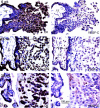

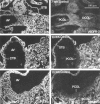
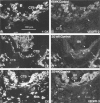
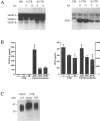





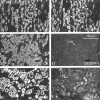

References
-
- Damsky CH, Fisher SJ: Trophoblast pseudo-vasculogenesis: faking it with endothelial adhesion receptors. Curr Opin Cell Biol 1998, 10:660-666 - PubMed
-
- Queenan Jr JT, Kao LC, Arboleda CE, Ulloa-Aguirre A, Golos TG, Cines DB, Strauss JFD: Regulation of urokinase-type plasminogen activator production by cultured human cytotrophoblasts. J Biol Chem 1987, 262:10903–10906 - PubMed
-
- Even-Ram S, Uziely B, Cohen P, Grisaru-Granovsky S, Maoz M, Ginzburg Y, Reich R, Vlodavsky I, Bar-Shavit R: Thrombin receptor overexpression in malignant and physiological invasion processes. Nat Med 1998, 4:909-914 - PubMed
-
- Walker JJ: Pre-eclampsia. Lancet 2000, 356:1260-1265 - PubMed
Publication types
MeSH terms
Substances
Grants and funding
LinkOut - more resources
Full Text Sources
Other Literature Sources
Medical
Miscellaneous

